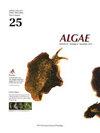Effects of light-emitting diodes on protoplast regeneration from gametophytic cells of the commercial kelp Undaria pinnatifida (Laminariales, Phaeophyceae)
IF 2.4
3区 生物学
Q1 MARINE & FRESHWATER BIOLOGY
引用次数: 2
Abstract
Light-emitting-diodes (LEDs) are a lighting source useful for the precise evaluation of light quality effect on biological systems. Despite the importance of light spectra on the regeneration of land plant protoplasts (“naked cells”), this factor has not been tested yet on protoplasts from multicellular algae. This study reports on the effects of pure primary colors (red, blue, and green), dichromatic (red plus blue, RB, 1 : 2) and white LEDs on protoplast regeneration from male and female Undaria pinnatifida gametophytes. We also evaluated the effect of different light spectra on pigment composition (chlorophyll a, chlorophyll c, and fucoxanthine), and the light intensities under the best condition on the regeneration process. In the early stages, blue or RB LEDs increased the percentage of dividing female protoplasts, whereas red, blue, and RB LEDs enhanced that of dividing male protoplasts. In the later stages, RB LEDs showed a positive effect only on the percentage of multiple rhizoid-like protrusions (male gametophyte). They also increased the final area of both regenerated gametophytes. The LEDs did not affect pigment composition in female gametophytes. In male gametophytes, in contrast, they reduced chlorophyll c, while blue, RB, and green LEDs decreased fucoxanthin. Under RB LEDs, the optimal light intensity was 80 μmol photons m-2 s-1 for female gametophytes and 40 to 60 μmol photons m-2 s-1 for male gametophytes. Our results suggest that dichromatic LED illumination (red–blue) improves regeneration of U. pinnatifida gametophyte-isolated protoplasts. Thus, dichromatic LEDs might a suitable light source for enhancing protoplast regeneration in brown seaweeds.发光二极管对海带配子体细胞原生质体再生的影响
发光二极管(led)是一种用于精确评价光质量对生物系统影响的光源。尽管光谱对陆地植物原生质体(“裸细胞”)再生的重要性,但这一因素尚未在多细胞藻类原生质体上进行过测试。本研究报道了纯原色(红、蓝、绿)、二色(红加蓝、RB、1:2)和白光led对裙带菜雌雄配子体原生质体再生的影响。我们还研究了不同光谱对叶绿素a、叶绿素c和岩藻黄嘌素组成的影响,以及最佳条件下光照强度对再生过程的影响。在早期,蓝色和RB led增加了雌性原生质体的分裂率,而红色、蓝色和RB led增加了雄性原生质体的分裂率。在后期,RB LEDs仅对多个根状突起(雄性配子体)的百分比有积极影响。它们还增加了两种再生配子体的最终面积。led对雌性配子体色素组成没有影响。相比之下,在雄性配子体中,它们降低了叶绿素c,而蓝色、RB和绿色led降低了岩藻黄素。在RB led下,雌性配子体的最佳光强为80 μmol光子m-2 s-1,雄性配子体的最佳光强为40 ~ 60 μmol光子m-2 s-1。本研究结果表明,二色LED照明(红-蓝)可促进羽石楠配子体分离原生质体的再生。因此,二色led可能是提高褐藻原生质体再生的合适光源。
本文章由计算机程序翻译,如有差异,请以英文原文为准。
求助全文
约1分钟内获得全文
求助全文
来源期刊

Algae
PLANT SCIENCES-
CiteScore
5.10
自引率
25.00%
发文量
18
期刊介绍:
ALGAE is published by the Korean Society of Phycology and provides prompt publication of original works on phycology. ALGAE publishes articles on all aspects of phylogenetics and taxonomy, ecology and population biology, physiology and biochemistry, cell and molecular biology, and biotechnology and applied phycology. Checklists or equivalent manu-scripts may be considered for publication only if they contribute original information on taxonomy (e.g., new combinations), ecology or biogeography of more than just local relevance. Contributions may take the form of Original Research Articles, Research Notes, Review Articles and Book Reviews.
 求助内容:
求助内容: 应助结果提醒方式:
应助结果提醒方式:


